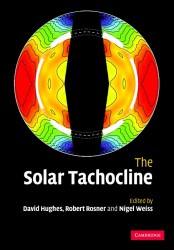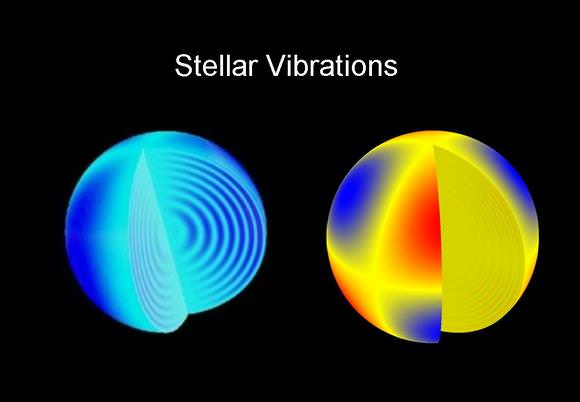[/caption]
Asteroseismology is a relatively new field in astronomy. This branch uses sound waves in stars to explore their nature in the same way seismologists on Earth have used waves induced by tectonic activity to probe the interior of our planet. These waves aren’t heard directly, but as they strike the surface they can cause it to undulate, shifting the spectral lines this way and that, or compress the outer layers causing them to brighten and fade which can be detected with photometry. By studying these variations, astronomers have begun peering into stars. This much is generally known, but some of the specific tricks aren’t often brought up when discussing the topic. So here’s five things you can do with asteroseismology you may not have known about!
1. Determine the Age of a Star
From high school science you should know sound will travel through a medium at a characteristic speed for a given temperature and pressure. This information tells you something about the chemical composition of the star. This is a fantastic thing since astronomers can then check that against predictions made by stellar models. But astronomers can also take that one step further. Since the core of a star slowly converts hydrogen to helium over its lifetime, that composition will change. How much it has changed from its original composition towards the point where there’s no longer enough hydrogen to support fusion, tells you how far through the main sequence lifetime a star is. Since we know the age of the solar system very well from meteorites, astronomers have calibrated this technique and begun using it on other stars like α Centauri. Spectroscopically, this star is expected to be nearly identical to the Sun; it has very similar spectral type and chemical composition. Yet a 2005 study using this technique pinned α Cen as 6.7 ± 0.5 billion years which is about one and a half billion years older than the Sun. Obviously, this still has a rather large uncertainty to it (nearly 10%), but the technique is still new and will certainly be refined in the future.
And if that wasn’t cool enough by itself, astronomers are now beginning to use this technique on stars with known planets to get a better understanding of the planets! This can be important in many cases since planets will initially glow more brightly in younger systems since they still retain heat from their formation and this amount of extra light could confuse astronomers on just how might light is being reflected leading to inaccurate estimates of other properties like size or reflectivity.
2. Determine Internal Rotation

We already know that stars rotation is a bit funny. They rotate faster at their equator than at their poles, a phenomenon known as differential rotation. But stars are also expected to have differences in rotation as you get deeper. For stars like the Sun, this effect is related to a difference in energy transport mechanisms: radiative, where energy is conducted by a flow of photons in the deep interior, to convective, where energy is carried by bulk flow of matter, creating the boiling motion we see on the surface. At this boundary, the physical parameters of the system change and the material will flow differentially. This boundary is known as the tachocline. Within the Sun, we’ve known it’s there, but using asteroseismology (which, when used on the Sun is known as helioseismology), astronomers actually pinned it down. It’s 72% the way out from the core.
3. Find Planets
Until very recently, the most reliable way to find planets has been to look for the spectroscopic wiggle as the planets tug the star around. This technique sounds very straightforward, and it can be, unless the star has a lot of wiggle of its own due to the effects that make asteroseismology possible. Those effects can easily be much larger than those created by planets. So if you want to find planets lost in the forest of noise, you’d best understand the effects caused by the pulsating stellar surface. After astronomers cancelled out those effects on V391 Pegasi, they discovered a planet. And what a weird one it was. This planet is orbiting a sub-dwarf star, which is the helium core of a post-main sequence star which has ejected its hydrogen envelope. Of course, this occurs during the red giant phase when the star should have swollen up to engulf the gas giant planet in orbit. But apparently the planet survived, or somehow came along later.
4. Find Buried Sunspots
Turning to recent news, helioseismology recently found some sunspots. This wouldn’t be a big deal. Anyone with a properly filtered telescope can find them. Except these ones were buried some 60,000 km beneath the Sun’s surface. By using the seismic data, astronomers found an overdense region beneath the surface. This region was caused, just as sunspots are, by a tangle in the magnetic field keeping the material in place. As it rose to the surface, it became a sunspot. Here’s the vid:
5. Make “Music”
Because many of the events that create the soundwaves in stars are periodic, they are rhythmic in nature. This has prompted many explorations into using these naturally created beats to make music. A direct example is this one which simply assigns tones to the modes of pulsation. The site also notes that the beat created by one of the stars, has been used as a base for club music in Belgium. This has also been done for longer “symphonies” by Zoltan Kollath.


At the fifth paragraph, in the third line, there’s a “t” missing in straightforward.
Also, at the last paragraph, in the second line, rhythmic is misspelled.
(You can delete this afterwards.)
I’m glad asteroseismology is getting some good PR. It is becoming such an important field and holds potential to unlock so many secrets about the interior of stars and the information is has already provided about the Sun is invaluable.
I did want to clarify, though, that V391 Pegasi is a hot sub-dwarf, not to be confused with the metal-poor cool sub-dwarfs. Nitpicking, I know, but a very important distinction, nonetheless.
I’m glad asteroseismology is getting some good PR. It is becoming such an important field and holds potential to unlock so many secrets about the interior of stars and the information is has already provided about the Sun is invaluable.
I did want to clarify, though, that V391 Pegasi is a hot sub-dwarf, not to be confused with the metal-poor cool sub-dwarfs. Nitpicking, I know, but a very important distinction, nonetheless.